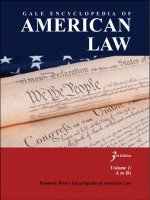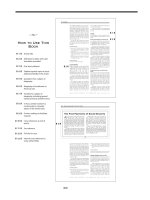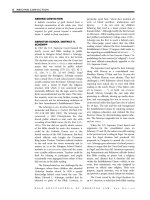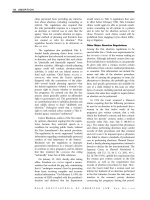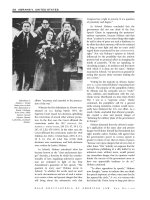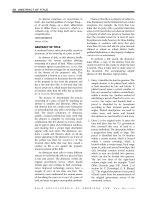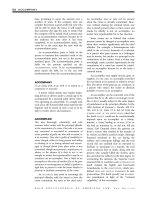Gale Encyclopedia Of American Law 3Rd Edition Volume 1 P4 pot
Bạn đang xem bản rút gọn của tài liệu. Xem và tải ngay bản đầy đủ của tài liệu tại đây (152.6 KB, 10 trang )
clinic personnel from providing any informa-
tion about abortion, including counseling or
referral. The regulations also required that
the only permissible response to a request for
an abortion or referral was to state that the
agency “does not consider abortion an appro-
priate method of planning and therefore does
not counsel or refer for ab ortion.” This
regulation became known to its detractors as
the
GAG RULE.
The regulations also prohibited Title X-
funded family planning clinics from
LOBBYING
for legislation that advocated or increased access
to abortion, and they required that such clinics
be “physically and financially separate” from
abortion activities. Although a family planning
agency could still conduct abortion-related
activities, it could not use federal money to
fund such activities. Chief Justice
WILLIAM H.
REHNQUIST, who wrote the Court’s opinion,
disagreed with the contentions of the plain-
tiffs—several family planning agencies—that
the federal regulations violated a woman’s due
process right to choose whether to terminate
her pregnancy. He pointed out that the due
process clause generally confers no affirmative
right to government aid. The government has
no constitutional duty to subsidize abortion and
may validly choose to fund “childbirth over
abortion.” Rehnquist noted that a woman’s
right to seek medical advice outside a Title X-
funded agency remained “unfettered.”
Justice Blackmu n, author of the Roe major-
ity opinion, dissented, arguing that the regula-
tions, because they restricted speech as a
condition for accepting public funds, violated
the First Amendment’s free speech provision.
The regulations, he wrote, suppressed “truthful
information regarding constitutionally protected
conduct of vital importance to the listener.”
Blackmun saw the regulations as improper
government interference in a woman’s decision
to continue or end a pregnancy, and he claimed
that they rendered the
LANDMARK Roe ruling
“technically” intact but of little substance.
On January 22, 1993, shortly after taking
office, President
BILL CLINTON signed a memo-
randum that revoked the gag rule, maintaining
that it “endangers women’s lives by preventing
them from receiving complete and accurate
medical information.” On February 5, 1993, the
secretary of HHS complied with the president’s
decision and declared that the department
would return to Title X regulations that were
in effect before February 1988. Title X-funded
clinics would again be able to provide nondi-
rective counseling on all options to a patient
and to refer her for abortion services if she
chose. However, such clinics would still be
prohibited from engaging in pro-choice lobby-
ing or litigation.
Other Major Abortion Regulations
Among the first abortion regulations to be
enacted after Roe v. Wade were requirements for
the
INFORMED CONSENT of the woman seeking an
abortion. Although informed consent laws vary
from jurisdiction to jurisdiction, it can generally
be given only after a woman receives certain
information from a doctor, medical professional,
or counselor. This information can include the
nature and risks of the abortion procedure,
the risk of carrying the pregnancy to term, the
alternatives to abortion, the probable age of the
fetus, and specific government aid available for
care of a child. Related to this issue are other
types of consent, including parental and spousal
consent, that states have sought to require before
an abortion can be performed.
In 1976 the Court reviewed a Missouri
statute requiring that the following provisions
be met for an abortion to be performed: that a
woman in the first twelve weeks of her
pregnancy give written consent; that a wife
obtain her husband’s consent; and that a minor
obtain her parents’ consent, unless a medical
necessity exists (Mo. Ann. Stat. § 188.010 et
seq.). The statute also required that physicians
and clinics performing abortions keep careful
records of their procedures and that criminal
and civil
LIABILITY be imposed upon a physician
who failed to observe standards of professional
care in performing abortions. Planned Parent-
hood, a family planning organization, initiate d a
lawsuit to declare the law unconstitutional. The
Supreme Court, in Planned Parenthood v.
Danforth, 428 U.S. 52, 96 S. Ct. 2831, 49 L.
Ed. 2d 788 (1976), upheld the requirement that
the woman give written consent in the first
trimester, as well as the requirement that
records of abortion procedures be kept. How-
ever, the Court ruled that a woman need not
inform her husband of an abortion performed
in the first trimester, because the state may not
interfere in the woman’s private decision
concerning her pregnancy during that period.
GALE ENCYCLOPEDIA OF AMERICAN LAW, 3RD E DITION
18 ABORTION
For the same reason, the Court struck down
the law requiring a minor to obtain parental
consent in the first trimester.
The Court clarified its position on parental
consent in later rulings. In Bellotti v. Baird, 443 U.
S. 622, 99 S. Ct. 3035, 61 L. Ed. 2d 797 (1979), it
struck down a state law that required the consent
of both parents or judicial approval—commonly
called judicial bypass—before an unmarried
minor could obtain an abortion. The Court
found the law unconstitutional because it gave
third parties—the child ’s parents or the court—
absolute
VETO power over the minor’s ability to
choose abortion, regardless of her best interests,
maturity, or ability to make informed decisions.
In H.L. v. Matheson, 450 U.S. 398, 101 S. Ct.
1164, 67 L. Ed. 2d 388 (1981) , the Court upheld
a Utah statute requiring that a physician notify
the parents of a minor before performing an
abortion on her (Utah Code Ann. § 76-7-304).
Because the law required only notification
rather than consent, the Court reasoned that it
did not give any party veto power over the
minor’s decision. In Hodgson v. Minnesota, 497
U.S. 417, 110 S. Ct. 2926, 11 L. Ed. 2d 344
(1990), the Court upheld a parental notification
statute because the statute’s provision for
judicial bypass took into account the best
interests of the minor, her maturity, and her
ability to make an informed decision. In Ayotte
v. Planned Parenthood of Northern New England,
546 U.S. 320, 126 S. Ct. 961, 163 L. Ed. 2d 812
(2006), the Court revie wed another parental
notification statute that did not contain an
exception to allow a minor to obtain an
abortion without notice to her parent when
necessary to preserve the minor’s health. The
Court remanded the case to the lower federal
courts to determine whether the statute as a
whole had to be stricken or whether parts of the
statute could remain intact.
In 1982 Pennsylvania passed the Abortion
Control Act, which required that the woman
give “voluntary and informed” consent after
hearing a number of statements, including
declarations of the following: the “fact that
there may be detrimental physical and psycho-
logical effects” from the abortion; the particular
medical risks associated with the abortion
method to be employed; the probable gesta-
tional age of the fetus; the “fact that medical
assistance benefits may be available” for prena-
tal care and childbirth; and the “fact that the
father is liable to assist” in
CHILD SUPPORT. The
law also required a physician to report the
woman’s age, race,
MARITAL status, and number
of previous pregnancies; the probable gestational
age of the fetus; the method of payment for the
abortion; and the basis of determination that “a
child is not viable.”
When the Pennsylvania law came before the
Court in the 1986 case Thornburgh v. American
College of Obstetricians & Gynecologists, 476 U.S.
747, 106 S. Ct. 2169, 90 L. Ed. 2d 779, the
Reagan admi nistration’s Justice Department
specifically asked the Court to overturn Roe.
In its brief, the department argued that the
Court should “abandon” Roe because its textual
and historical basis was “so far flawed” as to be a
source of instability in the law. Instead, the brief
urged, the Court should leave the state legis-
latures free to permit or prohibit abortion as
they wish. However, by a 5–4 vote the Court
found all the provisions of Pennsylvania’s
Abortion Control Act to be unconstitutional,
thereby reaffirming its previous decisions up-
holding a woman’s constitutional right to
abortion. “The states,” wrote Justice Blackmun
in the Court’s opinion, “are not free, under the
guise of protecting maternal health or potential
life, to intimidate women into continuing
pregnancies.” Pennsylvania defended itself by
claiming that its procedures gave the pregnant
woman information that would better inform
her decision regarding abortion. Blackmun,
although he agreed in principle with the idea
of informed consent, found that the Penn sylva-
nia procedures were designed not so much to
inform as to encourage a woman to withhold
her consent to an abortion.
The narrow margin of the Court’s decision
encouraged the anti-abortion movement. By the
time the Court reached its next major abortion
decision, in 1992 (Planned Parenthood of
Southeastern Pennsylvania v. Casey, 505 U.S.
833, 112 S. Ct. 2791, 120 L. Ed. 2d 674), many
expected it to finally reverse Roe. Again, it did
not. Casey, the most important abortion deci-
sion since Roe, concerned amendments to the
same Pennsylvania Abortion Control Act of
1982. The amendments prohibited abortions
after 24 weeks except to save the woman’s life or
to prevent substa ntial and irreversible im-
pairment of her bodily functions; required a
woman to wait 24 hours after giving her
informed consent before receiving an abortion;
GALE ENCYCLOPEDIA OF AMERICAN LAW, 3RD E DITION
ABORTION 19
allowed only a physician to give informed-
consent information; required a woman to
notify her spouse; and mandated that minors
obtain informed consent from at least one
parent or a court before receiving an abortion.
The plaintiffs in the case, five family planning
clinics and a physician provider of abortion
services, asked the Court to declare the statutes
invalid.
In a 5–4 decision, the Court again supported
the basic provisions of Roe and upheld a
woman’s right to decide to obtain an abortion.
The Court did, however, uphold all the
Pennsylvania statutes except for the spousal
notification provision, arguing that they did not
present an “undue burden” to the woman’s
reproductive rights. Justices O’Connor, Ken-
nedy, and
DAVID H. SOUTER wrote the majority
opinion, and Justices JOHN PAUL STEVENS and
Blackmun wrote concurring opinions. Chief
Justice Rehnquist and Justices Scalia,
BYRON R.
WHITE, and CLARENCE THOMAS all dissented.
Noting that the case marked the fifth time
the Justice Department under the Ronald
Reagan and George H. W. Bush administrations
had filed a report with the Court making known
its desire to overturn Roe, the Court’s opinion
defended the reasoning of the Roe decision. The
Court characterized the Roe ruling as having
three major provisions:
First is a recognition of the right of the
woman to choose to have an abortion before
viability and to obtain it without undue
interference from the state. Second is a
confirmation of the State’s power to restrict
abortions after fetal viability, if the law
contains exceptions for pregnancies which
endanger a woman’s life or health. And third
is the principle that the State has legitimate
interests from the outset of the pregnancy in
protecting the health of the woman and the
life of the fetus that may become a child.
In Casey, as in Roe, the Court found the
constitutional basis of a woman’s right to
terminate her pregnancy in the due process
clause of the Fourteenth Amendment. As the
Court stated: “It is a promise of the Constitu-
tion that there is a realm of personal liberty
which the government may not enter.” The
Court also in voked the legal doctrine of
STARE
DECISIS
, the policy of a court to follow previously
decided cases rather than
OVERRULE them.
However, the Court emphasized, more than
it had in Roe, “the State’s important and
legitimate interest in potential life,” which is a
quotation taken directly from Roe. The justices
also sought to better define the “undue burden”
standard, originally developed by Justice
O’Connor, that the Court had used to assess
the validity of any possible regulations of a
woman’s reproductive rights. The Court more
precisely defined an undue burden as one whose
“purpose or effect is to place a substantial
obstacle in the path of a woman seeking an
abortion before the fetus attains viability.”
The dissenting justices in the case restated
their opinion that Roe was decided wrongly
because no
FUNDAMENTAL RIGHT for a w oman to
choose to terminate her pregnancy was written
into the U.S. Constitution and because U.S.
society in the past permitted laws that prohib-
ited abortion. They also gave different argu-
ments for upholding the Pennsylvania statute’s
restrictions. Such provisions had only to show a
“rational basis,” and using that test, they would
have upheld all the challenged portions of the
Pennsylvania law. Chief Justice Rehnquist and
Justice Scalia both argued that the Court had
misused the no tion of stare decisis in the case,
because the Court did not uphold all aspects of
Roe. Scalia also maintained that although the
liberty to terminate a pregnancy may be of great
importance to many women, it is not “a liberty
protected by the Constitution.”
The Court’s decision in Casey was used to
strike down other state laws that sharply
restricted women’s access to abortion. In
September 1992, citing the Casey decision in
Sojourner v. Edwards, 974 F.2d 27, the U.S.
Court of Appeals for the Fifth Circuit struck
down a Louisiana law that would have imposed
stiff sentences on doctors performing abortions
for reasons other than saving the life of the
mother or in cases of rape or incest if the victim
reported the crime (La. Rev. Stat. Ann. 14:87).
The appeals court found the statute unconstitu-
tional because it imposed an undue burden on
women seekin g an abortion before fetal viabili-
ty. The Supreme Court later upheld this ruling
without comment (Sojourner, 507 U.S. 972, 113
S. Ct. 1414, 122 L. Ed. 2d 785 [1993]).
After Planned Parenthood v. Casey
As a result of the Court’s decision in Planned
Parenthood of Southeas tern Pennsylvania v.
Casey, the battle over abortion moved beyond
the question of whether Roe v. Wade would be
overturned to focus on w hat conditions truly
GALE ENCYCLOPEDIA OF AMERICAN LAW, 3RD E DITION
20 ABORTION
constitute an American woman’s right to safe,
legal abortion. After a number of violent
incidents at abortion clinics, the abortion rights
movement focused on lobbying for legislation
and winning court cases guaranteeing access to
abortion clinics. The anti-abortion movement,
by contrast, continued to vigorously oppose
abortion but became increasingly split between
militant and moderate factions. Behind the split
was an alarming increase in violent actions by
militant anti-abortion protesters. During 1993
and 1994, five abortion providers were killed
by anti-abortion militants. Although such kill-
ings undermined public supp ort fo r the anti-
abortion movement, they also damaged the
morale of those w ho staff family planning
clinics; some clinics even shut down. As a
result, family planning services, including
abortion, remain difficult to obtain for women
in many parts of the United States, particularly
in rural areas.
The Supreme Court decided a number of
different cases surrounding the issue of anti-
abortion protests, many of which made it more
difficult for anti-abortion groups to disrupt the
operations of family planning clinics. In Madsen
v. Women’s Health Center, 512 U.S. 753, 114 S.
Ct. 2516, 129 L. Ed. 2d 593 (1994), the Court
upheld a regulation barring abortion protesters
within 36 feet of a Melbourne, Florida, clinic. In
another 1994 decision, National Organization
for Women v. Scheidler, 510 U.S. 249, 114 S. Ct.
798, 127 L. Ed. 2d 99, the Court upheld the use
of the Racketeer Influenced and Corrupt
Organizations (RICO) chapter of the
ORGANIZED
CRIME
Control Act of 1970 (18 U.S.C.A. §§
1961–1968) against militant anti-abortion
groups. RICO, which was originally designed
to combat Mafia crime, gives the government a
potent tool to convict those involved in violence
against abortion providers and their clinics.
In May 1994 President Clinton signed into
law another tool to be used against anti-
abortion militants, the Freedom of Access to
Clinic Entrances Act (FACE), which allows for
federal criminal prosecution of anyone who, “by
force or threat of force or by physical obstruc-
tion, intentionally injures, intimidates, or inter-
feres with any person obtainin g or
providing reproductive health services” (18 U.S.
C.A. § 248). The law also makes it a federal
crime to intentionally damage or destroy the
property of any reproductive health facility, and
it permits persons harmed by those engaging in
prohibited conduct to bring private suits against
the wrongdoers. The law imposes stiff penalties
as well for those found guilty of violating its
provisions.
Ultimately, medical technology may have as
much to do with the outcome of the abortion
debate as politics. New drugs have been devel-
oped that induce abortion without a surgical
procedure. The best known of these is RU-486,
or mifepristone, developed by the French
pharmaceutical company Roussel Uclaf. The
drug blocks the action of the female hormone
progesterone, preventing the impla ntation of a
fertilized egg in the wall of the uterus. It is used
with a second drug in pill form, prostaglandin,
taken 48 hours later, which causes uterine
contractions. The uterine lining is then sloughed
off, along with any fertilized eggs. Widely used in
Europe since the early 1990s, RU-486 is said to
be 92 to 95 percent effective. In the early 2000s,
the drug was also being tested as a possible
treatment for breast cancer, endometriosis, brain
tumors, and depression.
The
FOOD AND DRUG ADMINISTRATION (FDA),
under the Reagan and Bush administrations,
banned the importation of RU-486 into the
United States. However, in April 1993 the
Clinton administrat ion pressured Roussel Uclaf
to license the drug for sale to the United States.
Population Council, a New York-based
NON-
PROFIT
organization, said it would conduct
clinical tests in the United States. In 1994 the
pharmaceutical company donated its U.S.
PATENT of the drug to the council. By 1996 the
Population Council had filed for FDA approval,
and in September 2000, the FDA approved the
“abortion pill.” Danco Laboratories, a New
York-based women’s health pharmaceutical
company which had been given the rights by
the council to manufacture and distribute
mifepristone, made the drug available to U.S.
clinics by November. In the two years following
its introduction, more than one hundred thou-
sand women in the United States chose mife-
pristone as an abortion option. Abortion pro-
testers quickly rallied and began to
PETITION the
FDA to RESCIND its approval of the drug, claiming
that mifepristone is harmful to women.
The Pro-Life Movement and the Courts
Even before the Supreme Court’s landmark
1973 abortion ruling i n Roe v. Wade, anti-
abortion groups were
PICKETING and protesting
GALE ENCYCLOPEDIA OF AMERICAN LAW, 3RD E DITION
ABORTION 21
at family planning clinics that perform abor-
tions. Such groups had formed in response to
an abortion reform movement that by 1970 had
succeeded in liberalizing abortion laws in many
states. From the start, most anti-abortion
demonstrators modeled their protests on those
of the
CIVIL RIGHTS movement of the 1950s and
1960s. The anti-abortion movement was led by
such people as Joan Andrews, a pacifist and
HUMAN RIGHTS ADVOCATE who became a hero for
the movement after she spent two-and-a-half
years in a Florida jail for attempting to disengage
a suction machine used in abortions. The
movement advocated the nonviolent approach
to civil disobedience pioneered by
MOHANDAS K.
GANDHI and MARTIN LUTHER KING Jr. By 1975, two
years after Roe, Catholic groups had begun to
conduct sit-ins at family planning clinics where
abortions were performed. With time, evangelical
Protestant groups joined the movement, and by
the mid-1990s they accounted for a majority of
anti-abortion activists.
Anti-abortion groups have labeled their
activities as direct actions or rescues, believing
that they are saving unborn children from
murder, and their tactics have grown increas-
ingly complex. Typical stratagems include
bringing in dozens or hundreds of volunteers
and blocking clinic entrances with their bodies,
often chaining themselves to doors; shouting
slogans, sometimes with bullhorns; attempting
to intercept women leaving or entering the
building and plying them with anti-abortion
literature; displaying graphic pictures of fetuses;
and trailing clinic employees to and from work
while shouting such labels as “Baby killer!”
Besides demonstrating, anti-abortion groups
have sponsored pregnancy crisis centers, where
they counsel pregnant women, with the inten-
tion of persuading them to carry their pregnan-
cies to term. By the mid-1980s, activists had
created national organizations and networks
that promoted civil disobedience to stop the
practice of abortion. One well-known organiza-
tion is Operation Rescue, which was started in
the 1980s by Randall Terry, an evangelical
Christian.
The aggressive strategies of the anti-abortion
movement prompted legal responses from
women’s and abortion rights organizations,
resulting in a number of cases that have reached
the Supreme Court. In several different rulings,
the Court has attempted to clarify what is and is
not allowed in anti-abortion demonstrations. In
making these decisions, the Court has been
careful to balance the rights of the demonstra-
tors—particularly their right to free speech—
with the rights of women seeking to use family
planning clinic services. In 1988, for example, in
Frisby v. Schultz, 487 U.S. 474, 108 S. Ct. 2495,
101 L. Ed. 2d 420, the Court upheld a
Brookfield, Wisconsin, city
ORDINANCE prohibit-
ing pickets “focused on, and taki ng place in
front of, a particular residence.” The ordinance
had been created in response to anti-abortion
demonstrations targeting the private home of an
obstetrician who performed abortions, a tactic
used by the protesters after picketing at the
physician’s clinic had not stopped its operation.
Justice Sandra Day O’Connor wrote in the
Court’s opinion, “There is simply no right to
force speech into the home of an unwilling
listener.”
A later Supreme Court decision gave
abortion clinics further protection: It supported
the constitutionality of a court injunction
prohibiting protesters from going within 36
feet of a clinic that had been a regular target of
protests. In July 1994, in Madsen v. Women’s
Health Center, 512 U.S. 753, 114 S. Ct. 2516,
129 L. Ed. 2d 593, the High Court ruled 6–3to
let stand the 36-foot exclusion zone for the
Melbourne, Florida, abortion clinic. However,
the Court did strike down other provisions of
the injunction, such as a 300-foot exclusion
zone and restrictions on carrying banners and
pictures. The ruling was considered a major
defeat for the anti-abortion movement. Justice
Antonin Scalia wrote a sharp dissent in which
he claimed that the Supreme Court’s position
on abortion had claimed “its latest, greatest and
most surprising victim: the First Amendment.”
Increased Violence Changes the Debate
Violence has been a part of the heated debat e
surrounding abortion ever since the 1973 Roe v.
Wade decis ion that guaranteed a woman’s
limited right to an abortion. Bombings,
ARSON,
and even murder have been committed by anti-
abortion activists in the name of their cause.
The National Abortion Federation counted
more than three thousand violent or threaten-
ing incidents against abortion clinics between
1976 and 1994. In the 1990s the extremist wing
of the anti-abortion movement turned even
more violent, including murder as part of its
GALE ENCYCLOPEDIA OF AMERICAN LAW, 3RD E DITION
22 ABORTION
tactics. Some extremists now view killing health
care professionals who perform abortions as
justifiable
HOMICIDE.
Between March 1993 and the end of 1994,
five staff workers at abortion clinics were
murdered by anti-abortion zealots. Dr. David
Gunn was fatally shot on March 10, 1993,
outside an abortion clinic in Pensacola, Florida,
by Michael Griffin, who was later sentenced to
life in prison. In August 1994 Dr. John Bayard
Britton, age 69, who had replaced Gunn as
circuit-riding doctor in northern Florida, and
his escort, James Barrett, age 74, were shot
repeatedly in the face with a shotgun as their car
pulled into the parking lot of the Ladies Clinic
of Pensacola. Minutes later, police arrested Paul
Hill, an anti-abortion extremist. President Bill
Clinton called Britton’s and Barrett ’s killings a
case of domestic
TERRORISM. Hill was executed in
September 2003. In December 1994, in perhaps
the most gruesome incident of all, John Salvi
killed two people and w ounded five more when
he opened fire in two Boston-area family
planning clinics. Salvi was sentenced to life in
prison, where he later committed
SUICIDE.
The government and abortion rights groups
have responded to the increased violence in two
ways: reviewing existing laws to find those that
can be used to investigate and
PROSECUTE violent
groups and individuals, and creating new laws
that specifically address access to abortion
clinics. In 1993 women’s rights groups
attempted to use an existing civil rights law as
precedence in Bray v. Alexandria Women’s
Health Clinic, 506 U.S. 263, 113 S. Ct. 753,
122 L. Ed. 2d 34 (1993). They were not
successful. The Supreme Court ruled that a
nineteenth-century federal civil rights law
(42 U.S.C.A. § 1985[3] ) aimed at protecting
African Americans from the
KU KLUX KLAN could
not be used to prevent anti-abortion protesters
from blockading abortion clinics. Originally
enacted as part of the
KU KLUX KLAN ACT of
1871, the law was specifically aimed at addres-
sing mob violence and
VIGILANTISM against
African Americans.
In 1989 a lower-court ruling found that
Operation Rescue had violated trespassing and
public
NUISANCE laws and had conspired to
violate the right to interstate travel of women
seeking abortions at clinics. The court banned
Operation Rescue from trespassing on or
obstructing access to abortion clinics (NOW v.
Operation Rescue, 726 F. Supp. 1483 [E.D. Va.
1989]). This decision was reversed by the
Supreme Court in Bray, in a 6–3 ruling, when
it held that women did not qualify as a class
protected from
DISCRIMINATION by the provisions
of the Ku Klux Klan Act.
After Bray, congressional supporters of
abortion rights, Representative Charles E.
Schumer (D-N.Y.) and Senator
EDWARD M.
KENNEDY (D-Mass.), introdu ced the Fre edom of
Access to Clinic Entrances Act (FACE), which
gives federal courts the authority to issue
restraining orders against protesters blockading
abortion clinics (18 U.S.C.A. § 248). Signed into
law by President Clinton on May 26, 1994, the
law allows for federal criminal prosecution of
anyone who, “by force or threat of force or by
physical obstruction, intentionally injures, inti-
midates, or interferes with any person
obtaining or providing reproductive health
services.” The law also makes it a federal crime
to intentionally damage or destroy the property
of any reproductive health facility, and it
permits persons harmed by those engaging in
prohibited conduct to bring private suits against
the wrongdoers. The penalties for violation of
the act include
IMPRISONMENT for up to one year
and a fine of $10,000 for a first offense; for each
subsequent offense, penalties can be up to three
years’ imprisonment and $25,000. FACE is
patterned after existing civil rights laws, includ-
ing 18 U.S.C.A. § 245(b), which prohibits force
or threat of force to willfully injure, intimidate,
or interfere with any person who is
VOTING,
engaging in activities related to voting, or
enjoying the benefits of federal programs.
Nevertheless, FACE is not identical to previous
federal civil rights laws, particularly where it
prohibits acts of physical obstruction.
FACE ignited immediate challenges by anti-
abortion groups who claimed that it abridged
their
FIRST AMENDMENT right to FREEDOM OF
SPEECH
. Courts were unwilling to invalidate the
law on this ground, reasoning that the law
prohibits only conduct—as in “force,”“threat
of force,” and “physical obstruction”—rather
than speech (see Council for Life Coalition v.
Reno, 856 F. Supp. 1422, No. 94-0843-
1EG[CM], 1994 WL 363132 [S.D. Cal. 1994]).
Since the Freedom of Access to Clinic
Entrances Act was passed, the Supreme Court
has reviewed several laws restricting protests
at clinics, with the goal of balancing the
GALE ENCYCLOPEDIA OF AMERICAN LAW, 3RD E DITION
ABORTION 23
interests of protecting women seeking abortions
with the freedom of speech interests of abortion
clinic protesters. The Court has used an
“intermediate scrutiny” standard to make its
determinations. This standard analyzes the
constitutionality of any regulation that infringes
on speech to see whether it serves a legitimate
STATE INTEREST, whether it is narrowly tailored to
serve that interest, and whether alternative paths
exist for protesters to communicate their
message.
For example, in Schenck v. Pro-Choice
Network, 519 U.S. 357, 117 S. Ct. 855 (1997),
by an 8–1 vote, the Court invalidated a New
York state court injunction that created a 15-
foot “floating” buffer zone around any person
or vehicle seeking access to or leaving an
abortion clinic. The court majority held that
Three Sides to the Abortion
Debate
T
o what extent does a woman have a
right to obtain an abortion? And to
what extent does a person have a right to
PROTEST the practice of abortion? These
two fundamental questions and two
conflicting rights emerged in the decades
following the U.S. Supreme Court’s
controversial decision in the 1973 case
ROE V. WADE (410 U.S. 113, 93 S. Ct. 705,
35 L. Ed. 2d 147). With time, the conflict
between those who differed on the
answers to these questions, and the
interpretation of these rights, became
more intense and at times even violent.
The question of access to abortion clinic
property—whether to obtain clinic ser-
vices or to protest them—became a
pressing issue.
Three major points of view dominate
the abortion debate: the pro-choice, or
abortion rights, view; the moderate pro-
life, or moderate anti-abortion, view; and
the extremist (or militant) pro-life, or
anti-abortion, view.
The pro-choice, or abortion rights,
side of the debate is made up of a
number of women’s rights, family plan-
ning, and medical organizations, and
other groups of concerned citizens and
professionals. The groups include the
NATIONAL ORGANIZATION FOR WOMEN
(NOW), the Planned Parenthood Feder-
ation of America, the National Abortion
Federation, and the National Abortion
and Reproductive Rights Action League
(NARAL). Many religious organizations
have also taken positions that endorse
the right of women to seek abortions in
specific situations. Most of these pro-
choice groups argue that a woman’s
decision to carry a pregnancy to term is
a private choice that should not be
interfered with by the state. They also
maintain that abortion, although not a
preferred family planning method, has
always been used by women to gain
control over their pregnancies. Accord-
ing to this view, women must have safe
and legal access to abortion; without this
access, women are likely to seek unsafe,
illegal abortions that may result in their
injury or death. Pro-choice advocates
also maintain that giving women control
over their reproductive functions— what
they call their reproductive rights —is a
fundamental requirement for achieving
equality between men and women in
U.S. society. Norma McCorvey, who
sought anonymity as Jane Roe in Roe
and who in 1995 switched sides on the
abortion issue, spoke for the pro-choice
position in a 1989 speech before a
women’s rally:
Prior to Roe v. Wade, approxi-
mately one million women had
illegal abortions each year. Ap-
proximately 5,000 of these wom-
en were killed. Another 100,000
were hospitalized from botched
abortions.
Obviously, abortion will
continue whether it is legal or
not. My concern is for the safety
of millions of women should
our freedom of choice be taken
away from us. I want it clearly
understood that I do not pro-
mote abortion. I promote per-
sonal choice.
If we return to the antique
methods of dealing with un-
wanted pregnancies that existed
before Roe v. Wade, the women’s
movement will be taking an
enormous step backward. We
are on the verge of having our
reproductive freedom taken
away from us if we do not take
a stand and let our voices be
heard NOW.
Pro-choice groups remain commit-
ted to the
CONSTITUTIONAL right to PRIVACY
defined in Roe. They view anti-abortion
demonstrations that prevent women
from obtaining abortions as interfering
with that right to privacy.
The pro-choice group also has a
range of viewpoints within it. Whereas all
persons who describe themselves as
pro-choice support a general right to
abortion, some oppose some kinds of
abortions, such as late-term abortions.
The moderate pro-life movement
consists of many different organizations,
including the
NATIONAL RIGHT TO LIFE
COMMITTEE
, HUMAN RIGHTS Review, and
Feminists for Life of America. Although
its members are extremely diverse, most
come from religious groups such as
the Catholic Church and evangelical
GALE ENCYCLOPEDIA OF AMERICAN LAW, 3RD E DITION
24 ABORTION
the floating buffer zone burdened “more speech
than necessary to serve a relevant government
interest.” However, by a 6–3 vote, the Court
upheld a provision creating a 15-foot “fixed”
buffer zone outside abortion clinic doorways,
driveways, and parking lots.
Three years later, the Court issued a more
detailed decision involving restrictions on
abortion protests. In Hill v. Colorado, 530 U.S.
703, 120 S. Ct. 2480 (2000), the Court upheld
by a 6–3 majority a Colorado statute that made
it
UNLAWFUL for any person within one hundred
feet of the entrance to any abortion clinic (or
other health facility) to knowingly approach
within eight feet of another person without that
person’s consent, with the purpose of passing
Protestant denominations. Generally,
these groups believe that the fetus is a
person with rights equal to those of other
people, and some of these identify the
unborn person as existing from the
moment of conception or in the embry-
onic stage. Many are willing to allow
abortion in certain cases, usually when
pregnancy threatens the health of the
mother or has resulted from
RAPE or
INCEST. Moderates in their manner of
supporting changes in abortion laws and
regulations differ from militants. Mod-
erates emphasize using existing legal
channels to bring about change.
Militant pro-life groups share many
of the views of moderate groups, but they
favor an activist use of
CIVIL DISOBEDIENCE to
prevent abortion procedures and to save
or rescue the lives of the unborn. Randall
Terry and Flip Benham, of the most well
known anti-abortion group, Operation
Rescue, represent the militant views. Terry
is Operation Rescue’s founder and leading
figure; he participated in his first anti-
abortion protest in 1984 and has served
time in prison because of his demonstra-
tions. As an evangelical Protestant Chris-
tian, Terry sees abortion as the work of the
devil: “I believe that there is a devil, and
here’sSatan’s agenda. First, he doesn’t
want anyone having kids. Secondly, if they
do conceive, he wants them killed. If
they’re not killed through abortion, he
wants them neglected or abused, physical-
ly, emotionally, sexually.” Terry opposes
abortion in all cases. His group’smain
tactics, he is quoted as saying, include
“rescue missions, boycotts and protests.”
A minority of the militant anti-
abortion activists sanctions the use of
physical force. A small number even
regard the killing of abortion providers as
justifiable
HOMICIDE. When asked to
explain this increasing tendency toward
violence, militant pro-life leader Joseph
Scheidler, of the Pro-Life Action Net-
work, blamed it on the 1994 Freedom of
Access to Clinic Entrances Act (FACE)
and buffer zone restrictions that kept
protesters from conducting rallies at
abortion clinics. Scheidler argued that
making it tougher to have peaceful
protests gave people a rationale for
having violent protests. Benham, of
Operation Rescue, condemned the anti-
abortion killings. However, after John
Salvi murdered two people and wounded
others in an abortion clinic shooting in
late 1994, Benham commented, “There
is little that federal marshals or anyone
else can do to halt this
MURDER and
violence. We will not have peace outside
the womb until peace is restored within
the womb.” Added Terry, “We’re in-
volved in a cultural civil war.” When
Kansas obstetrician George Tiller was
killed in May 2009, Terry called the
doctor a “mass-murderer” and com-
pared him to a Nazi war criminal.
Scheidler and his group won a major
victory in 2003 when the U.S. Supreme
Court ruled 8–1 that the RICO statute
was improperly used against the group
and other pro-life activists, in the case
brought against them by the National
Organization for Women (Scheidler v.
Nat’l Organization for Women, Inc., 537
U.S. 393, 123 S. Ct. 1057, 154 L. Ed. 2d
991 [2003]).
It is possible the extremist position
may have done more to hurt than to
help the anti-abortion cause. The publi-
cized violence of the movement, in
combination with the new prosecutorial
powers granted in FACE, served to
ALIENATE many of the more moderate
individuals in pro-life groups, reducing
the membership of those groups to a
militant core and making those outside
the groups less sympathetic to their
cause. However, extremists have contrib-
uted to a climate in which access to
abortion services has steadily become
more difficult. The number of abortion
providers declined by 2 percent between
2000 and 2005. By 2008, 87 percent of
all U.S. counties lacked an abortion
provider.
But as a positive result of the fallout,
significant numbers from both sides tried
to find common ground and an end to
the mutual mistrust and ill will. Aptly
calling themselves the Common Ground
Network for Life and Choice, the alliance
made its largest impact with the political
issue of partial-birth abortions, when it
began a campaign to ban the procedures.
This more subtle collective voice of
concerned citizens appeared to represent
an important change in the direction of
abortion debate. In specific, the commit-
ted extremists on both ends were being
replaced with a new and more sophisti-
cated national consensus concerning the
acceptable limits of abortion rights. The
Partial Birth Abortion Ban Act was
enacted in 2003 and upheld by the
Supreme Court in Gonzales v. Carhart
(550 U.S. 124, 127 S. Ct. 1610, 167 L. Ed.
2d 480 [2007]).
FURTHER READING
Risen, James, and Judy L. Thomas. 1998.
Wrath of Angels: The American Abortion
War. New York: Basic Books.
CROSS REFERENCES
Civil Rights Acts; Schools and School
Districts.
GALE ENCYCLOPEDIA OF AMERICAN LAW, 3RD E DITION
ABORTION 25
out a leaflet or handbill to, displaying a sign to,
engaging in oral
PROTEST with, or counseling said
individual. The Court reasoned that the states’
interest in protecting the health and safety of its
citizens justified a special focus on unimpeded
access to healthcare facilities and the avoidance
of potential trauma to patients that could result
from confrontational protests. In addition, the
statute did not violate the First Amendment
because it protected listeners from unwanted
communication, was content-neutral, and
served as a valid time, place, and manner
restriction.
Abortion rights supporters suffered a more
serious setback with the Court’s decision in
Scheidler v. NOW & Operation Rescue v. NOW,
123 S. Ct. 1057 (U.S. 2003). By a vote of 8–1,
the Court determined that federal
RACKETEERING
laws, such as RICO, could not be used as the
basis for criminal charges against anti-abortion
protestors who demonstrate outside abortion
clinics. The Court further found that the federal
Hobbs Act was not violated by protestors who
had not obtained property, attempted to obtain
property, or conspired to obtain property from
the abortion clinics. The Hobbs Act, 18 U.S.C.A.
§ 1951(b)(2), expanded the common-law
definition of
EXTORTION to include acts by private
individuals. For purposes of the Hobbs Act
requirement that property must be obtained for
extortion to occur, the word obtain means to
gain possession of. The extortion provision of
the Hobbs Act requires not only the depriva-
tion, but also the acquisition, of property.
Women seeking access to the abortion clinic
had argued that their right to seek medical
services from the clinics, the clinic doctors’
rights to perform their jobs, and the clinics’
rights to conduct their business—constituted
“property” for purposes of the Hobbs Act, and
those rights had been “extorted” from them by
abortion protestors.
The Supreme Court held that by interfer ing
with, disrupting, and in some instances “shut-
ting down” clinics that performed abortions,
individual and corporate organizers of anti-
abortion protest network did not “obtain” or
attempt to obtain property from women’s rights
organization or abortion clinics, and so did not
commit “extortion” under the Hobbs Act, as
required for organization and clinics to establish
RICO predicate offense; whereas organizers may
have deprived or sought to deprive organizations
and clinics of their alleged
PROPERTY RIGHT of
exclusive control of their business assets, they did
not acquire any such property, nor did they
pursue or receive something of value from
organizations or clinics that they could exercise,
transfer, or sell. The Court also ruled that an
injunction obtained against the abortions pro-
testers litigating this case on the basis of RICO
was invalid.
The debate and litigation surrounding the
issue of anti-abortion protests show little sign of
waning, with pro-choice advocates attempting
to limit protesters’ efforts to demonstrate at
abortion clinics, and anti-abortion protest
groups challenging the laws regulating their
activities, on the grounds that such laws abridge
freedom of speech.
New Attempts to Restrict Abortion
Some state lawma kers have not ended their
efforts to ban abortions. In 2006 the South
Dakota
LEGISLATURE approved a bill that would
have banned most abortions. Pro-choice acti-
vists immediately announced that they would
challenge the law, but the issue was eventually
resolved by voters in the state. When the statute
became subject to the general election in 2006,
voters in the state defeated the proposal by a 55
to 45 percent margin.
The Supreme Court continues to be
confronted with ongoing efforts to restrict
abortion. In Mazurek v. Armstrong, 520 U.S.
968, 117 S. Ct. 1865 (1997), the Court up-
held Montana’s statute requiring that only
licensed physic ians perform abortions, ruling
that physician-o nly requirements in general are
constitutional. In another decision out of
Montana, Lambert v. Wicklund, 520 U.S. 292,
117 S. Ct. 1169 (1997), the Court upheld a state
statute requiring one-parent notification before
a minor can have an abortion. The judicial
bypass procedure in this case required a minor
to show that parental notification was not in her
best interest.
Perhaps the biggest controversy to erupt in
the late 1990s involved the debate over what is
termed partial-birth abortion. Anti-abortion
activists succeeded in having legislation passed
in 29 states that bans physicians from perform-
ing what doctors call dilation and extraction. It
is used most commonly in the second trimester,
between 20 and 24 weeks of pregnancy, when a
woman suffers from a life-threatening medical
GALE ENCYCLOPEDIA OF AMERICAN LAW, 3RD E DITION
26 ABORTION
condition or disease. In Stenberg v. Carhart, 530
U.S. 914, 120 S. Ct. 2597 (2000), by a 5–4 vote,
the Court struck down Nebraska’s ban on
partial-birth abortion. The Court ruled the
statute was invalid because it lacked any
exception to protect a woman’s health, noting
that the state could promote but not endanger a
woman’s health when it regulates the met hods
of abortion. It also concluded that terms in the
statute were unconstitutionally vague such that
it would affect not only partial birth abortion
but also other constitutionally protected sec-
ond-trimester abortion methods.
In early 2003 the U.S. Congress passed the
Partial Birth Abortion Ban Act, Pub. L. No. 108-
105, 117 Stat. 1201, which contained a ban
similar to the Nebraska law. The Congress had
passed this law before, only to have Bill Clinton
veto it. President
GEORGE W. BUSH went on record
as saying he would sign the bill if it reached his
desk. When he did so, the Supreme Court was
called upon to decide whether Stenberg applied.
In Gonzales v. Carhart, 550 U.S. 124, 127 S. Ct.
1610, 167 L. Ed. 2d 480 (2007), the Court
upheld the act, ruling that it did impose an
undue burden on a woman’s right to end a
pregnancy. The two newest members of the
Court, Chief Justice
JOHN ROBERTS and Justice
SAMUEL ALITO, voted in the majority, confirming
that the recent appointees had solidified the
conservative base on the Court. The decision
also revealed a new interest in the mother’s
health and safety.
FURTHER READINGS
Drucker, Dan. 1990. Abortion Decisions of the Supreme
Court, 1973 through 1989: A Comprehensive Review with
Historical Commentary. Jefferson, N.C.: McFarland.
De Rosa, Melissa. 2002. “Partial-Birth Abortion: Crime or
Protected Right?” St. John’s Journal of Legal Commen-
tary 16 (winter).
Edwards, Jaime. 2003. “McGuire v. Reilly: The First
Amendment and Abortion Clinic Buffer Zones in the
Wake of Hill v. Colorado.” U.C. Davis Law Review 6
(February).
Mauro, Tony. 2003. “Weighing the Fate of Roe v. Wade:
With Increased Fervor after the 30 Years of Legal and
Social Turmoil It Spawned, Scholars Kick It, Probe It,
Tear It Apart and Try to Rewrite It.” New Jersey Law
Journal 171 (January).
McCorvey, Norma. 1994. I Am Roe. New York: Harper-
Collins.
Palmer, Louis J. 2009. Encyclopedia of Abortion in the United
States. 2d ed. Jefferson, N.C.: McFarland.
Perry, Michael J. 2009. Constitutional Rights, Moral
Controversy, and the Supreme Court. New York: Cam-
bridge University Press.
Reagan, Ronald. 1984. Abortion and the Conscience of a
Nation. Nashville: Nelson.
Rubin, Eva R. 1987. Abortion, Politics, and the Courts: Roe v.
Wade and Its Aftermath. New York: Greenwood.
CROSS REFERENCES
Constitutional Amendment; Fetal Rights; Husband and
Wife; Parent and Child; Privacy; Reproduction; “Roe v.
Wade” (Appendix, Milestone); Wattleton, Alyce Faye;
Women’sRights.
ABRAMS V. UNITED STATES
In Abrams v. United States, 250 U.S. 616, 40
S.Ct. 17, 63 L.Ed. 1173 (1919), the U.S.
Supreme Court applied the
CLEAR AND PRESENT
DANGER
test in upholding the conviction of five
anti-war protestors, who had been charged with
SEDITION for distributing pamphlets criticizing
President
WOODROW WILSON during WORLD WAR I.
However, the case is remembered more for the
lone dissenting opinion written by Justice Oliver
Wendell Holmes Jr., architect of the original
clear-and-present-danger test just eight months
earlier. Holmes’s dissent argued that
FREEDOM OF
SPEECH
cases analyzed under the FIRST AMENDMENT
to the U.S CONSTITUTION must be subjected to a
heightened level of judicial scrutiny before
LEGISLATION abridging free expression could be
upheld, a level of scrutiny that was eventually
adopted by a majority of the Court for the
balance of the twentieth century.
The case began on August 23, 1918, when
Jacob Abrams, a Russian immigrant and a
professed anarchist, was arreste d in New York
City with four others. Abrams and his comrades
admitted to writing, printing, and distributing
two sets of leaflets, one in English and one in
Yiddish, assailing President Woodrow Wilson as
a “coward” and a “hypocrite” for sending
troops to fight the Soviet Union during World
War I. The Yiddish leaflet called for a general
strike among all workers to protest against
Wilson’s policy.
Abrams and the other defendants were
charged with violating the Sedition Act. This
act made it a crime to “willfully utter, print,
write, or publish any disloyal, profane, scurri-
lous, or abusive” language about the form of
government in the United States or language
that was intended to bring that form of
government “into contempt, scorn, contumely,
and disrepute,” or language that was “intended
to incite, provoke, and encourage resistance to
the” U.S. war effort. The act also made it illegal
to “willfully urge, incite, or
ADVOCATE [the]
curtailment” of manufacturing and production
GALE ENCYCLOPEDIA OF AMERICAN LAW, 3RD E DITION
ABRAMS V. UNITED STATES 27

